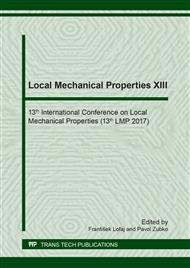p.79
p.85
p.91
p.97
p.103
p.108
p.114
p.120
p.127
Mechanical Properties of Build-Up Layers on Failed Ceramic Roller
Abstract:
The paper describes degradation process of ceramic rollers. Rollers behavior under mechanical and thermal load was evaluated using available methods like XRD, instrumented hardness measurement and compressive strength. The influence of residual stresses was also discussed. The first phase during the degradation crystalize from amorphous silica tridymite, cristobalite and quartz, then due to the contact and pressure of the steel strip to the surface roller iron diffuses and forms fayalite. Measured values of compression strength of roller of 55-61 MPa agree with producer documentation declared minimal values. Hardness and Young´s modulus of buildup phases identified from surface into depth were determined. Wüstite was present up to 100 mm, with hardness 6±1 GPa, Young´s modulus 75±6 GPa, fayalite, cristobalite, up to 500 mm, with hardness 5.4±0.6 GPa, Young´s modulus 51±2 GPa, tridymite over 500 mm, with the hardness 7±4 GPa and Young´s modulus 58±25 GPa.
Info:
Periodical:
Pages:
103-107
Citation:
Online since:
October 2018
Authors:
Keywords:
Price:
Сopyright:
© 2018 Trans Tech Publications Ltd. All Rights Reserved
Share:
Citation:


